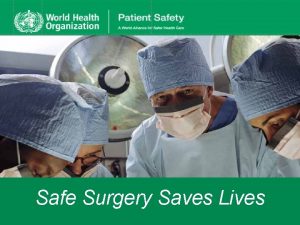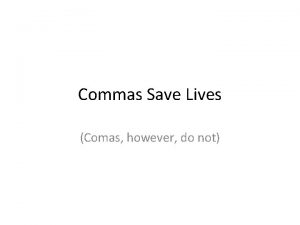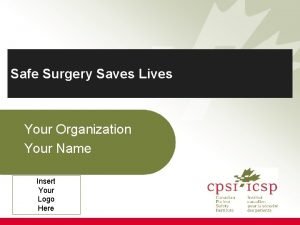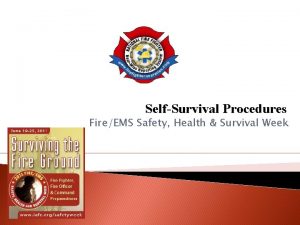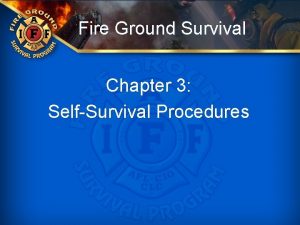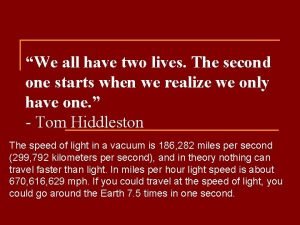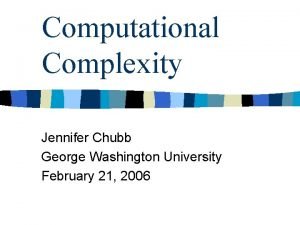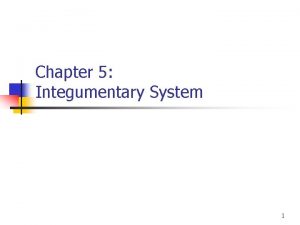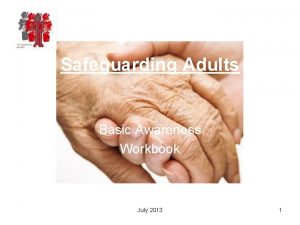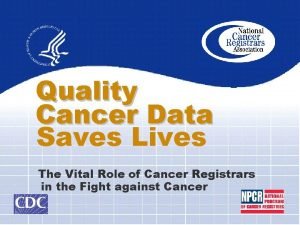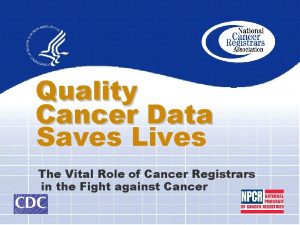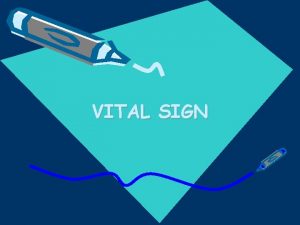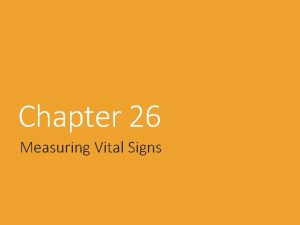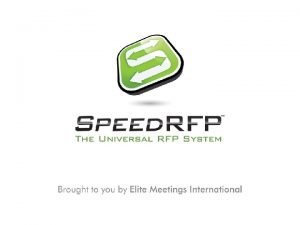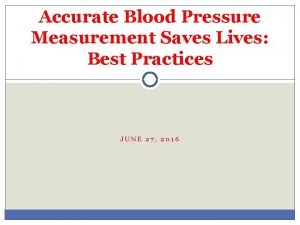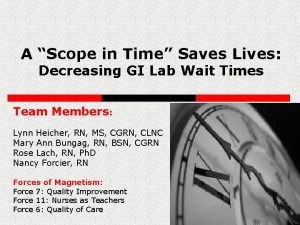Quality Cancer Data Saves Lives The Vital Role

























































































































- Slides: 121

Quality Cancer Data Saves Lives The Vital Role of Cancer Registrars in the Fight against Cancer

18 Million

1. 5 million


67%

Cancer Registries Statistics n Treatment strategies n Public health initiatives n

United States Cancer Statistics 2008

Goal The ultimate goal of collecting cancer information is to prevent and control cancer and improve patient care

Result Assist physicians in assessing the efficacy of diagnostic and therapeutic methods

Result Aid in the decision making about unmet needs, physician recruitment, space needs, resource allocation, and health planning

Result Respond to local needs through an assessment of referral patterns, cancer trends, and development opportunities

Cancer Registries collect a wide range of cancer-related information; including — n Demographics

Cancer-related Information Medical history n Diagnosis and prognosis indicators n Treatment patterns n Cancer recurrence n Survival rates n Health care coverage n Patient eligibility n

Different Kinds of Cancer Registries

Health care providers record patient information and diagnosis Hospital-based cancer registrar abstracts patient information into uniform data sets and checks for an existing record for each patient Patient data is aggregated on a state level, and then sent to national registries (SEER or NPCR)

Hospital Cancer Registry

State Cancer Registry

National Cancer Data Base http: //www. facs. org/cancer/ ncdb/index. html

Surveillance Epidemiology and End Results Program (SEER) http: //seer. cancer. gov/

1973+ 9 States, 6 Metro Areas 28% of population coverage

National Center for Health Statistics Cancer mortality comes from State Health Depts. to the CDC’s NCHS

National Program of Cancer Registries

National Program of Cancer Registries NPCR* Seattle/Puget Sound SEER † NPCR & SEER Detroit CT IA San Francisco/ Oakland San Jose/ Monterey N J UT CA KY Los Angeles NM Atlanta LA HAWAII ALASKA Pacific Islands Jurisdiction PUERTO RICO *National Program of Cancer Registries (CDC) Epidemiology, and End Results Program (NCI) †Surveillance,

NPCR is expanding efforts to improve and use cancer data by: Providing technical assistance to registries to help ensure data completeness, timeliness, and quality

Coordinating and convening meetings of registry personnel for information sharing, problem solving, and training

Helping states and national organizations use cancer data to describe state and national disease burdens, evaluate cancer control activities, and identify populations at risk for certain cancers

Collaborating with federal, state, and private organizations to design and conduct research using data collected through state registries

CDC: National Standards n CDC has established national standards to ensure the completeness, timeliness, and quality of Cancer Registry data

NPCR provides national leadership to Cancer Registries NAACCR Certified State Registries 2011 • • • Gold Silver Black- did not meet certification requirements

Today, NPCR and SEER registries work collaboratively to collect and report cancer statistics on the entire U. S. population. http: //www. cdc. gov/cancer/ npcr/uscs/

International Association of Cancer Registries

How Registries Collect Cancer Data

The techniques used by Cancer Registrars allow for uniform data collection. http: //www. naaccr. org/

Standard setting organizations provide guidance and direction to the Cancer Registrar

A patient’s file, or abstract, contains many different sections and fields

Abstracting is converting a patient’s medical information to uniform cancer data

Electronic Medical Records

Cancer Registries have embraced technology

Cancer Registries exist within a national framework of health monitoring and data collection

History of Cancer Information


1629 Cancer recorded as a cause of death 1839 Death registration in the U. S.

1923 First U. S. Cancer Registry launched

1932 First Central State registry – Connecticut 1956 ACo. S Co. C requires cancer programs to have registries

1971 National Cancer Act establishes SEER Program 1974 Nationwide cancer registrations begins

1974 NCRA Chartered 1983 NCRA begins administering CTR examination

1990 NAACCR established

1992 NPCR created by Cancer Registries Amendment Act 1996 ACo. S Co. C requires data submission to NCDB

The Flow of Cancer Information: A Case Study

Diagnosis to treatment n Jane Smith learns from her internist that she likely has breast cancer

Diagnosis to treatment n Further tests are completed at the hospital

Diagnosis to treatment n Jane’s doctor proposes a course of treatment

Diagnosis to treatment n Follow-up tests show Jane to be cancer free

Diagnosis to treatment n Jane’s data is added to other SEER and Michigan central Cancer Registry data, and the National Cancer Data Base, where it will go through more quality processes and refinement

Diagnosis to treatment n The Cancer Registrar will regularly followup

Cancer Information is Used to Improve Prevention, Research, and Care

Cancer information is used in thousands of ways, including — Evaluate patient outcome, quality of life, and satisfaction issues and implement procedures for improvement

Evaluate efficacy of treatment modalities

Provide outcome information for cancer surveillance http: //www. cdc. gov/cancer/ npcr/uscs/

Report cancer incidence as required by state and federal laws http: //www. ccrcal. org/pdf/ Reports/Physicians. pdf

Trends in Five-Year Relative Survival Rates Estimated Numbers of US Cancer Survivors by Sex and Time Since Diagnosis as of January 1, 2012 Male Time since diagnosis Number Percent Cummulative Percent Female Number Percent Cummulative Percent 0 to <5 years 2, 608, 320 40% 2, 339, 950 32% 5 to <10 years 1, 628, 010 25% 65% 1, 595, 410 22% 54% 10 to <15 years 997, 060 15% 80% 1, 135, 160 16% 70% 15 to <20 years 570, 290 9% 89% 791, 880 11% 81% 20 to <25 years 305, 140 5% 94% 536, 670 7% 88% 25 to <30 years 154, 470 2% 96% 343, 300 5% 92% 30+ years 179, 010 3% 499, 210 7% 100% Note: Percentages may not sum to 100% due to rounding. Source: Data Modeling Branch, Division of Cancer Control and Population Sciences, National Cancer Institute. Calculate survival rates by various data items, such as sex, race, and age

Provide information for cancer prevention activities

Analyze referral patterns

Allocate resources at local, state, and national levels

Develop educational programs for health care providers, patients, and the general public

Cancer data form much of the body of knowledge used by medical professionals, epidemiologists, policymakers, and public health officials

Kentucky Thousands of lives were saved in Kentucky through early detection of breast cancer

Arizona Careful analysis leads to broader cancer screening efforts in northeastern Arizona

Minnesota In Minnesota, a rare type cancer caused by asbestos exposure was identified, leading the state to look for increased state funding for occupational-related disease

Kansas Cancer registry data identified a lack of cancer care facilities

New York Cancer registry data are now used to educate New Yorkers about cancer risk factors

Cancer Registries and the Fight Against Cancer For more examples of registry data visit the NPCR Web Site http: //www. cdc. gov/cance r/npcr/success/index. htm

Cancer Registrars Ensure Accuracy and Privacy

Inaccurate data is useless, expensive, and often harmful

Health care providers record patient information and diagnosis Hospital-based cancer registrar abstracts patient information into uniform data sets and checks for an existing record for each patient National data is only as good as state and local data Patient data is aggregated on a state level, and then sent to national registries (SEER or NPCR)

Ensuring accuracy is a team effort

Privacy concerns are paramount to Cancer Registrars

Cancer Registrars: A challenging career requires quality education, and certification

High quality data results from trained specialists: Cancer Registrars

Cancer Registrars not only record data, they find and interpret it

The Cancer Registrar must have comprehensive knowledge about cancer diagnoses, treatment, and information management

Education for Health Information Management Professionals and Cancer Registrars are similar

The Cancer Registrar is a key member of health care team

Hospital-based Registrar’s Role Goes Beyond Data Collection Cancer Program Management n Cancer Committee Member n Monitor quality of Cancer Program Management n Provide benchmarks for quality comparison n

Hospital-based Registrar’s Role Goes Beyond Data Collection Data Analysis for Studies n Compiling Cancer Program Annual Report n Assess referral patterns n

Hospital-based Registrar’s Role Goes Beyond Data Collection Participate in cancer prevention n Present information to cancer committee, physicians, administration n

Registrars in Central Cancer Registries are Key Players in Ensuring Quality Health Care Edit the data from all facilities n Query the database for data quality reports n Merge duplicate records n Audit healthcare facilities to insure accurate, timely, complete data n

Registrars in Central Cancer Registries are Key Players in Ensuring Quality Health Care Work with researchers n Contribute to data analysis for cancer program planning n Present data to the local community, schools, and others n Provide education and training for registrars n

How Does One Become a Cancer Registrar?

Formal Education Programs Produce Excellent Cancer Registrars

CTRs have pursued higher education Some college, associates, bachelors

NCRA’s requirements for approval of formal education curricula include: Cancer and its management n Medical terminology n Anatomy and physiology n Biostatistics and epidemiology n Cancer data abstracting n Database record management n Cancer program management n Cancer registry procedures n

Other educational opportunities: Intensive trainings on specific subjects n On-the-job training n Online resources, including NPCR and SEER training modules n http: //www. training. seer. cancer. gov n SEER Self-Instructional Manuals http: //seer. cancer. gov/training/manuals

Certification of Cancer Registrars

Certification ensures quality results

Additional benefits: certification Establishing a standard of knowledge and competence n Measuring the requisite knowledge, skills and abilities of CTR® applicants n Promoting professional growth and individual study n Formally recognizing CTRs who meet recertification requirements n

Candidates who meet eligibility requirements and pass the CTR examination are awarded the CTR credential. NCRA’s Council on Certification sets the certification standards.

What are the eligibility requirements for certification? n Minimum education of an Associate’s degree n Practical experience

Route A n Successful completion of an NCRAaccredited degree program OR an NCRA-accredited certificate program PLUS an Associate degree or equivalent, AND 160 -hour practicum.

Route B n Completion of an Associate degree or equivalent (60 collegelevel credits) including or in addition to two semesters of college-level “Human Anatomy and Physiology” coursework, AND 1, 950 hours (equivalent to one year) of Cancer Registry experience.

CTR Exam Resources Council of Certification Website: http: //www. ctrexam. org n Eligibility: http: //www. ctrexam. org/eligibility n

CTR Examination Content Registry organization and operations n Anatomy, physiology, and histology of the human body n Abstracting and coding of cancer data items n

CTR Examination Content Statistical techniques, study design and report preparation n Practical application of registry principles n Computerized data management n

NCRA’s Council on Certification’s Mission n To create and maintain credentialing processes whereby the public can be assured that individuals certified by NCRA have met a level of competence required to provide accurate information for cancer surveillance and research activities

NCRA’s Certification Examination In 1983, the National Tumor Registrars Association (now NCRA) administered the first certification examination for tumor registry professionals.

Rapidly changing technology and treatment options necessitate continuing education

NCRA: Resources for Registrars

NCRA represents Cancer Registry professionals and CTRs

NCRA Mission Statement n Serve as the premier education, credentialing and advocacy resource for cancer data professionals.

NCRA Vision Statement n Improving lives through quality cancer data management

NCRA Core Values n Networking, Mentoring, and Making a Difference

NCRA offers: Multiple educational and networking opportunities n Annual national conference to build knowledge and expertise n Promotion of professional standards and ethics n

NCRA offers: Management of the CTR process and NCRA’s Council on Certification n Publication of a peerreviewed scientific journal and a quarterly newsletter n

NCRA offers: A Web site offering a wide range of publications and information about educational opportunities n http: //www. ncra-usa. org* n

Cancer Registry is a Dynamic Profession

Cancer Registry is a dynamic profession Registrars are dedicated, enthusiastic, and self motivated professionals n Registrars work closely with physicians and administrators n

Cancer Registry is a dynamic profession Registry data make a difference in patient care and cancer research n Registrars perform a wide variety of interesting tasks, including data analysis n

Cancer Registry is a dynamic profession The profession offers regular work day hours with holidays and vacations n There is minimal supervision required for self motivated registrars n

Cancer Registry careers are rewarding Masters Degree $55, 000 $39, 000 Associates Degree

Cancer Registrars Have Many Career Opportunities n n n Hospitals and Health Care Facilities Software Vendors Government Agencies Pharmaceutical Companies Outsourcing or Contract services

You and Cancer Registries: A Smart Choice for a Bright Future
 Safe surgery saves lives
Safe surgery saves lives Use commas save lives
Use commas save lives Safe surgery saves lives
Safe surgery saves lives Capacidad vital y capacidad vital forzada
Capacidad vital y capacidad vital forzada Journal entry 9
Journal entry 9 Our god saves
Our god saves Work saves us from 3 evils
Work saves us from 3 evils You are the god who saves
You are the god who saves Praise is rising hearts are turning to you
Praise is rising hearts are turning to you Fast food is very popular and saves time
Fast food is very popular and saves time Which of the two architecture saves memory? *
Which of the two architecture saves memory? * Let us sing of his love once again
Let us sing of his love once again What news does antonio receive at the play’s end? *
What news does antonio receive at the play’s end? * Yahweh saves
Yahweh saves Jesus alone saves
Jesus alone saves Azure web role vs worker role
Azure web role vs worker role Krappmann schaubild
Krappmann schaubild Role conflict occurs when fulfilling the role expectations
Role conflict occurs when fulfilling the role expectations Data quality and data cleaning an overview
Data quality and data cleaning an overview Data quality and data cleaning an overview
Data quality and data cleaning an overview Data quality is always a concern with secondary data
Data quality is always a concern with secondary data Data quality and data cleaning an overview
Data quality and data cleaning an overview Pouls apical
Pouls apical Perform quality assurance
Perform quality assurance Quality control vs quality assurance pmp
Quality control vs quality assurance pmp Pmbok quality management
Pmbok quality management Quality improvement vs quality assurance
Quality improvement vs quality assurance Compliance vs quality
Compliance vs quality Quality assurance concepts
Quality assurance concepts Quality guru
Quality guru Quality is free
Quality is free What is tqm
What is tqm Hình ảnh bộ gõ cơ thể búng tay
Hình ảnh bộ gõ cơ thể búng tay Slidetodoc
Slidetodoc Bổ thể
Bổ thể Tỉ lệ cơ thể trẻ em
Tỉ lệ cơ thể trẻ em Gấu đi như thế nào
Gấu đi như thế nào Tư thế worms-breton
Tư thế worms-breton Chúa yêu trần thế
Chúa yêu trần thế Môn thể thao bắt đầu bằng từ chạy
Môn thể thao bắt đầu bằng từ chạy Thế nào là hệ số cao nhất
Thế nào là hệ số cao nhất Các châu lục và đại dương trên thế giới
Các châu lục và đại dương trên thế giới Công của trọng lực
Công của trọng lực Trời xanh đây là của chúng ta thể thơ
Trời xanh đây là của chúng ta thể thơ Cách giải mật thư tọa độ
Cách giải mật thư tọa độ Phép trừ bù
Phép trừ bù độ dài liên kết
độ dài liên kết Các châu lục và đại dương trên thế giới
Các châu lục và đại dương trên thế giới Thể thơ truyền thống
Thể thơ truyền thống Quá trình desamine hóa có thể tạo ra
Quá trình desamine hóa có thể tạo ra Một số thể thơ truyền thống
Một số thể thơ truyền thống Cái miệng xinh xinh thế chỉ nói điều hay thôi
Cái miệng xinh xinh thế chỉ nói điều hay thôi Vẽ hình chiếu vuông góc của vật thể sau
Vẽ hình chiếu vuông góc của vật thể sau Biện pháp chống mỏi cơ
Biện pháp chống mỏi cơ đặc điểm cơ thể của người tối cổ
đặc điểm cơ thể của người tối cổ V cc
V cc Vẽ hình chiếu đứng bằng cạnh của vật thể
Vẽ hình chiếu đứng bằng cạnh của vật thể Vẽ hình chiếu vuông góc của vật thể sau
Vẽ hình chiếu vuông góc của vật thể sau Thẻ vin
Thẻ vin đại từ thay thế
đại từ thay thế điện thế nghỉ
điện thế nghỉ Tư thế ngồi viết
Tư thế ngồi viết Diễn thế sinh thái là
Diễn thế sinh thái là Các loại đột biến cấu trúc nhiễm sắc thể
Các loại đột biến cấu trúc nhiễm sắc thể Số.nguyên tố
Số.nguyên tố Tư thế ngồi viết
Tư thế ngồi viết Lời thề hippocrates
Lời thề hippocrates Thiếu nhi thế giới liên hoan
Thiếu nhi thế giới liên hoan ưu thế lai là gì
ưu thế lai là gì Sự nuôi và dạy con của hổ
Sự nuôi và dạy con của hổ Khi nào hổ con có thể sống độc lập
Khi nào hổ con có thể sống độc lập Hệ hô hấp
Hệ hô hấp Từ ngữ thể hiện lòng nhân hậu
Từ ngữ thể hiện lòng nhân hậu Thế nào là mạng điện lắp đặt kiểu nổi
Thế nào là mạng điện lắp đặt kiểu nổi Saikat islam lives with his parents in a flat in bogra
Saikat islam lives with his parents in a flat in bogra The secret lives of sgt john wilson
The secret lives of sgt john wilson The lives of others themes
The lives of others themes Who lives next door to rob independent or dependent
Who lives next door to rob independent or dependent Grab lives mnemonic
Grab lives mnemonic Meherjan passage summary
Meherjan passage summary In on at practice
In on at practice Mass media play an important part in our lives
Mass media play an important part in our lives My friend lives in moscow said alec
My friend lives in moscow said alec Sohan lives in a village
Sohan lives in a village Parasitism
Parasitism Fulfilling lives in islington and camden
Fulfilling lives in islington and camden Grab lives iaff
Grab lives iaff Nelson drawing the power of jesus christ
Nelson drawing the power of jesus christ What lives in the abyss
What lives in the abyss 6 word memoir for athletes
6 word memoir for athletes Omar is going to the watani football school
Omar is going to the watani football school Meherjan is now
Meherjan is now We all have two lives
We all have two lives My family lives at 3904 canal street in new orleans
My family lives at 3904 canal street in new orleans With christ my savior and my god
With christ my savior and my god Shared lives plus who pays for what
Shared lives plus who pays for what It is god who directs the lives of his creatures
It is god who directs the lives of his creatures Everything that lives and moves about will be food for you
Everything that lives and moves about will be food for you Living space poem
Living space poem Championing better work and working lives
Championing better work and working lives Canadas physical geography
Canadas physical geography Beowulf discussion questions
Beowulf discussion questions Meherjan lives in a slum
Meherjan lives in a slum Theme of i will always write back
Theme of i will always write back What was the noise that the country mouse heard
What was the noise that the country mouse heard The man lives next
The man lives next Nine lives causeway
Nine lives causeway My grown up christmas list link
My grown up christmas list link Who lives here
Who lives here Istdp criticism
Istdp criticism Jenny phelps
Jenny phelps How did the rise of islam change the lives of women?
How did the rise of islam change the lives of women? Who lives here
Who lives here During our lives we produce three kinds of hair
During our lives we produce three kinds of hair Voting districts definition ap human geography
Voting districts definition ap human geography Energy in our daily lives
Energy in our daily lives Eye contact is woven into the fabric of our daily lives.
Eye contact is woven into the fabric of our daily lives. Belgium royal family tree
Belgium royal family tree Nobody lives in this house question tag
Nobody lives in this house question tag Change lives
Change lives John lives
John lives Graham nuttall the hidden lives of learners
Graham nuttall the hidden lives of learners
